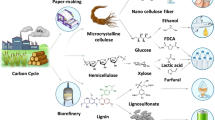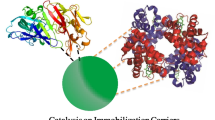Abstract
Although graphene oxide (GO) has great potential in the field of immobilized enzyme catalysts, the detailed effects of GO with different morphological structures on immobilized enzyme are not well understood. GOs were prepared from 8000 mesh and nanoscale graphite at different reaction temperatures, and used as carriers to immobilize alpha-amylase by cross-linking method. The properties of GOs were characterized through Atomic force microscope, Fourier-transformed infrared, X-ray photoelectron spectroscopy, Raman and UV–Vis. Furthermore, the dosage of cross-linking agent, cross-linking time, optimum temperature/pH, thermal/pH/storage stability, reusability and kinetic parameters of immobilized enzymes were investigated. The results showed that the loading of alpha-amylase on GOs was 162.3–274.2 mg g−1. The reusability experiments revealed high activity maintenance of immobilized alpha-amylase even after seven reaction cycles. Moreover, the storage stability of immobilized enzyme improved via immobilization in comparison with free one and it maintained over 70% of their initial activity after 20 days storage at 4 °C.










Similar content being viewed by others
References
Abbasi M, Amiri R, Bordbar AK, Ranjbakhsh E, Khosropour AR (2016) Improvement of the stability and activity of immobilized glucose oxidase on modified iron oxide magnetic nanoparticles. Appl Surf Sci 364:752–757
Zhao JF, Lin JP, Yang LR, Wu MB (2019) Enhanced performance of rhizopus oryzae lipase by reasonable immobilization on magnetic nanoparticles and its application in synthesis 1,3-diacyglycerol. Appl Biochem Biotechnol 188(3):677–689
Velmurugan R, Incharoensakdi A (2017) Immobilization of alpha-amylase on metal nanoparticles mediated by xylan aldehyde improves hydrolysis of glycogen from synechocystis sp. PCC 6803. Fuel 210:334–342
Straksys A, Kochane T, Budriene S (2016) Catalytic properties of maltogenic alpha-amylase from Bacillus stearothermophilus immobilized onto poly (urethane urea) microparticles. Food Chem 211:294–299
Hmidet N, Jemil N, Nasri M (2019) Simultaneous production of alkaline amylase and biosurfactant by Bacillus methylotrophicus DCS1: application as detergent additive. Biodegradation 30(4):247–258
Drozd R, Szymanska M, Rakoczy R, Junka A, Szymczyk P, Fijalkowski K (2019) Functionalized magnetic bacterial cellulose beads as carrier for lecitase (R) ultra immobilization. Appl Biochem Biotechnol 187(1):176–193
Gabrielczyk J, Duensing T, Buchholz S, Schwinges A, Jordening HJ (2018) A comparative study on immobilization of fructosyltransferase in biodegradable polymers by electrospinning. Appl Biochem Biotechnol 185(3):847–862
Shi JF, Yang C, Zhang SH, Wang XL, Jiang ZY, Zhang WY, Song XK, Ai QH, Tian CY (2013) Polydopamine microcapsules with different wall structures prepared by a template-mediated method for enzyme immobilization. ACS Appl Mater Interfaces 5(20):9991–9997
Jaquish R, Reilly AK, Lawson BP, Golikova E, Sulman AM, Stein BD, Lakina NV, Tkachenko OP, Sulman EM, Matveeva VG, Bronstein LM (2018) Immobilized glucose oxidase on magnetic silica and alumina: beyond magnetic separation. Int J Biol Macromol 120:896–905
Wang YZ, Li RF, Jia HG, Yang GX, Di YT, Xu CX, Ma LQ, Zhang H, Zhou YL, Zang Y, Xu SP, Sun ZY, Zu LW, Yue CG, Lan TY (2018) A novel silane coupling agent with peroxy groups used as an initiator in the graft polymerization of AN or MMA on nano-TiO2. Chem Pap 72(11):2871–2877
Huang QW, Zeng DW, Tian SQ, Xie CS (2012) Synthesis of defect graphene and its application for room temperature humidity sensing. Mater Lett 83:76–79
Yaragalla S, Rajendran R, AlMaadeed MA, Kalarikkal N, Thomas S (2019) Chemical modification of graphene with grape seed extract: its structural, optical and antimicrobial properties. Mater Sci Eng C Mater Biol Appl 102:305–314
Yang YF, Meng FY, Li XH, Wu NN, Deng YH, Wei LY, Zeng XP (2019) Magnetic graphene gxide-Fe3O4-PANI nanoparticle adsorbed platinum drugs as drug delivery systems for cancer therapy. J Nanosci Nanotechnol 19(12):7517–7525
Bidram E, Sulistio A, Cho HJ, Amini A, Harris T, Zarrabi A, Qiao G, Stewart A, Dunstan DE (2018) Targeted graphene oxide networks: cytotoxicity and synergy with anticancer agents. ACS Appl Mater Interfaces 10(50):43523–43532
Dedania SR, Patel MJ, Patel DM, Akhani RC, Patel DH (2017) Immobilization on graphene oxide improves the thermal stability and bioconversion efficiency of D-psicose 3-epimerase for rare sugar production. Enzyme Microb Technol 107:49–56
Xing YH, Lu PF, Wang J, Yang JP, Chen YP (2017) Defect-induced selective oxidation of graphene: a first-principles study. Appl Surf Sci 396:243–248
Wang MF, Qi W, Su RX, He ZM (2015) Advances in carrier-bound and carrier-free immobilized nanobiocatalysts. Chem Eng Sci 135:21–32
Chang CI, Chang KH, Shen HH, Hu CC (2014) A unique two-step Hummers method for fabricating low-defect graphene oxide nanoribbons through exfoliating multiwalled carbon nanotubes. J Taiwan Inst Chem Eng 45(5):2762–2769
Liu ZF, Chen ZH, Yu F (2018) Microencapsulated phase change material modified by graphene oxide with different degrees of oxidation for solar energy storage. Sol Energy Mater Sol Cells 174:453–459
Perreault F, de Faria AF, Nejati S, Elimelech M (2015) Antimicrobial properties of graphene oxide nanosheets: why size matters. ACS Nano 9(7):7226–7236
Pan N, Guan DB, Yang YT, Huang ZL, Wang RB, Jin YD, Xia CQ (2014) A rapid low-temperature synthetic method leading to large-scale carboxyl graphene. Chem Eng J 236:471–479
Romero A, Lavin-Lopez MP, Sanchez-Silva L, Valverde JL, Paton-Carrero A (2018) Comparative study of different scalable routes to synthesize graphene oxide and reduced graphene oxide. Mater Chem Phys 203:284–292
Bradford MM (1976) A rapid and sensitive method for the quantitation of microgram quantities of protein utilizing the principle of protein-dye binding. Anal Biochem 72:248–254
Paredes JI, Villar-Rodil S, Solis-Fernandez P, Martinez-Alonso A, Tascon JMD (2009) Atomic force and scanning tunneling microscopy imaging of graphene nanosheets derived from graphite oxide. Langmuir 25(10):5957–5968
Perez LAMD, Cepeda ABM, Alamilla RG, Armenta JLR, Valdez SS (2019) Nanostructures of graphene oxide modified with ZnO: synthesis and photocatalyst evaluation under sunlight. Fuller Nanotub Carbon Nanostruct 27(8):632–639
Royvaran M, Taheri-Kafrani A, Isfahani AL, Mohammadi S (2016) Functionalized superparamagnetic graphene oxide nanosheet in enzyme engineering: a highly dispersive, stable and robust biocatalyst. Chem Eng J 288:414–422
Wang JZ, Zhao GH, Jing LY, Peng XM, Li YF (2015) Facile self-assembly of magnetite nanoparticles on three-dimensional graphene oxide-chitosan composite for lipase immobilization. Biochem Eng J 98:75–83
Hong YL, Ryu S, Jeong HS, Kim YK (2019) Surface functionalization effect of graphene oxide on its liquid crystalline and assembly behaviors. Appl Surf Sci 480:514–522
Rana S, Bhaskaruni SVHS, Jonnalagadda SB (2018) Tri-amine functionalized graphene oxide for co-operative catalyst in the Henry reaction. Res Chem Intermed 44(3):2157–2167
Castaldo R, Lama GC, Aprea P, Gentile G, Lavorgna M, Ambrogi V, Cerruti P (2018) Effect of the oxidation degree on self-assembly, adsorption and barrier properties of nano-graphene. Microporous Mesoporous Mat 260:102–115
Chen JL, Zhang XM, Zheng XL, Liu C, Cui XQ, Zheng WT (2013) Size distribution-controlled preparation of graphene oxide nanosheets with different C/O ratios. Mater Chem Phys 139(1):8–11
Zhou HH, Zhai HJ, Zhi XM (2018) Enhanced electrochemical performances of polypyrrole/carboxyl graphene/carbon nanotubes ternary composite for supercapacitors. Electrochim Acta 290:1–11
Muthurasu A, Ganesh V (2014) Horseradish peroxidase enzyme immobilized graphene quantum dots as electrochemical biosensors. Appl Biochem Biotechnol 174(3):945–959
Dutta N, Biswas S, Saha MK (2017) Nano-magnesium aided activity enhancement and biophysical characterization of a psychrophilic alpha-amylase immobilized on graphene oxide nanosupport. J Biosci Bioeng 124(1):15–22
Wu R, Wang QY, Wang GS (2019) Immobilized enzyme on pulp fiber through layer-by-layer technique using cationic polyacrylamide for whitewater treatment from papermaking. Bioprocess Biosyst Eng 42:1583–1589
Hermanová S, Zarevucka M, Bousa D, Pumera M, Sofer Z (2015) Graphene oxide immobilized enzymes show high thermal and solvent stability. Nanoscale 7(13):5852–5858
Hong SG, Kim JH, Kim RE, Kwon SJ, Kim DW, Jung HT, Dordick JS, Kim J (2016) Immobilization of glucose oxidase on graphene oxide for highly sensitive biosensors. Biotechnol Bioprocess Eng 21(4):573–579
Kessi E, Arias JL (2019) Using natural waste material as a matrix for the immobilization of enzymes: chicken eggshell membrane powder for galactosidase immobilization. Appl Biochem Biotechnol 187(1):101–115
Zhuang W, Huang JS, Liu XJ, Ge L, Niu HQ, Wang ZF, Wu JL, Yang PP, Chen Y, Ying HJ (2019) Co-localization of glucose oxidase and catalase enabled by a self-assembly approach: matching between molecular dimensions and hierarchical pore sizes. Food Chem 275:197–205
Mulko L, Pereyra JY, Rivarola CR, Barbero CA, Acevedo DF (2019) Improving the retention and reusability of Alpha-amylase by immobilization in nanoporous polyacrylamide-graphene oxide nanocomposites. Int J Biol Macromol 122:1253–1261
Abi A, Wang AQ, Jordening HJ (2018) Continuous laminaribiose production using an immobilized bienzymatic system in a packed bed reactor. Appl Biochem Biotechnol 186(4):861–876
Amirbandeh M, Taheri-Kafrani A, Soozanipour A, Gaillard C (2017) Triazine-functionalized chitosan-encapsulated superparamagnetic nanoparticles as reusable and robust nanocarrier for glucoamylase immobilization. Biochem Eng J 127:119–127
Klapiszewski L, Zdarta J, Jesionowski T (2018) Titania/lignin hybrid materials as a novel support for alpha-amylase immobilization: a comprehensive study. Colloid Surf B-Biointerfaces 162:90–97
Acknowledgements
The project was supported by Open project of National Key Laboratory of Chemical Resource Engineering (Grants CRE-2017-C-305); Program for Innovative Research Team of Henan Polytechnic University (Grants T2018-3); The Natural Science Foundation of China (U1704127), Support plan for scientific and technological innovation team of colleges and universities in Henan Province (Grants 18IRTSTHN010).
Author information
Authors and Affiliations
Corresponding author
Ethics declarations
Conflict of interest
The authors declare that there is no any conflict of interest about this manuscript.
Additional information
Publisher's Note
Springer Nature remains neutral with regard to jurisdictional claims in published maps and institutional affiliations.
Rights and permissions
About this article
Cite this article
Zhang, H., Hua, SF., Li, Cq. et al. Effect of graphene oxide with different morphological characteristics on properties of immobilized enzyme in the covalent method. Bioprocess Biosyst Eng 43, 1847–1858 (2020). https://doi.org/10.1007/s00449-020-02375-9
Received:
Accepted:
Published:
Issue Date:
DOI: https://doi.org/10.1007/s00449-020-02375-9




